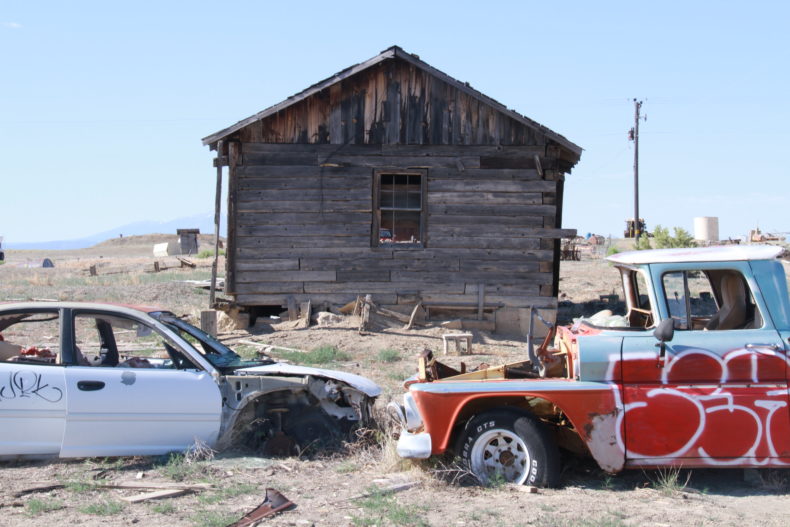 I don’t know when I first saw Cisco, Utah. My early memory of it is imprecise, gathered from a series of impressions over years into one blurry composite. A crumbling edifice of corner store, covered in a mural of eagle and mountains that is in turn covered in black scrawls of graffiti. Dead cars. Piles of brick, concrete and twisted metal. Great expanses of balding, cracked earth scattered with gunshot glass and rusted cans. Little shacks of gapped, silvered wood, standing like ribcages picked clean of meat by some scavenger. The wind, maybe. Or time. There is no hungrier thing lurking in the desert that surrounds that place.
I don’t know when I first saw Cisco, Utah. My early memory of it is imprecise, gathered from a series of impressions over years into one blurry composite. A crumbling edifice of corner store, covered in a mural of eagle and mountains that is in turn covered in black scrawls of graffiti. Dead cars. Piles of brick, concrete and twisted metal. Great expanses of balding, cracked earth scattered with gunshot glass and rusted cans. Little shacks of gapped, silvered wood, standing like ribcages picked clean of meat by some scavenger. The wind, maybe. Or time. There is no hungrier thing lurking in the desert that surrounds that place.
Like most people, until recently, I usually passed through Cisco on my way to something else—Moab, Canyonlands National Park, the canoe-able calm stretches of the Green River where I first learned the joy of dipping a paddle when I was 21. I wasn’t among those who stopped to poke around Cisco’s ruins. The town was mostly abandoned after the construction of four-lane Interstate 70 a couple miles away in the 1970s siphoned away the auto traffic that was its final gasp of prosperity. Its decay seemed best observed from a distance, and I thought that vantage gave me all of the information I needed. I felt I had been there, and integrated my brief experience with it into my sense of myself as a Westerner. Like a souvenir, albeit a scary one that looked like it might host a few vicious feral dogs. Just another boomtown gone bust.
There are a string of those along I-70, most with even sparser physical remains than Cisco’s. They had names like Westwater and Floy and used to be water stops on the steam-powered railroad that workers sutured into this landscape in the late 19th century. These towns were busy with sheepshearers, cowboys, boarding houses. The signs marking their exits now simply say “No Services.” The interstate permits you to drive 85 miles per hour past them, and at speed, it is difficult to understand them, or the land they used to occupy, as anything but empty.
Down the road from Cisco, Thompson Springs used to be one of the most happening hubs on the railroad. These days, it’s a scatter of a few dozen residents in modest homes, and the old hotels and railroad buildings stand vacant and boarded up along the tracks. Travelers who pull off in Thompson are more interested in its abandoned buildings than in the people still making a go of it, AJ Rogers, a lifelong resident, told me when I interviewed him for a story about Cisco. “They want it to be a ghost town,” he said.
I could see why they might. An unoccupied ruin with a cowboy past fits the archetypal, romantic vision of the American West much better than the suburbs, service economies, and real estate development that actually define the region now. And if a space seems empty, it’s much easier to go wherever you please and, in a way, claim it–as a part of your identity, a part of your story, like I had, even if you’re only there for a few minutes. It’s not so different from the way some of us might interact with a place we believe is wilderness because it seems free of human residents.
But however ravenous time’s appetites, if Cisco has taught me anything, it’s that no place is “empty,” nor has any ever been.
On my last visit there this June, I went swimming in the Colorado River with a young woman from the Midwest named Eileen Muza who had bought property in the busted town and was, improbably, building a home there. We paused at a boulder along the road into Moab. It was pecked with bighorn sheep, cougar, a coiling river—memories of more ancient inhabitants, here thousands of years before the railroad that gave Cisco its first purpose was even a dream.
“What’s crazy to me is that those petroglyphs will be here long after we’re dead,” Eileen said.
I looked at her. “What do you think will be around from Cisco long after we’re dead?” I asked.
“Nothing,” she said. She was quiet for a moment as she pulled the car back onto the road. “Or who knows. Maybe it will last forever.”